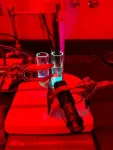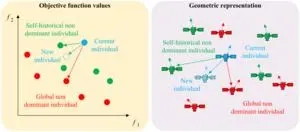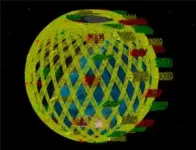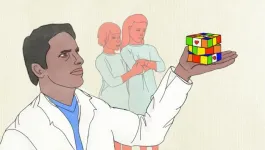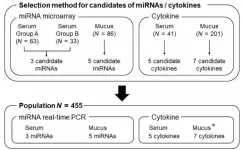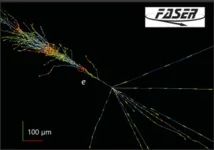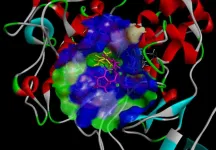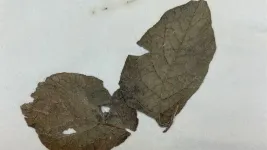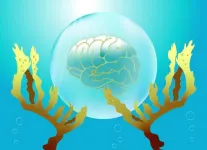Self-powered pump harnesses light and chemistry to target, capture pollutants
Dartmouth team develops light-controlled pump with potential applications for environmental cleanup.
2024-08-05
(Press-News.org) Dartmouth researchers have developed a self-powered pump that uses natural light and chemistry to target and remove specific water pollutants, according to a new report in the journal Science.
As water enters the pump, a wavelength of light activates a synthetic molecular receptor designed to bond to negatively charged ions, or anions, a class of pollutants linked to metabolic disruptions in plants and animals. A second wavelength deactivates the receptors as water exits the pump and causes them to release the pollutants, trapping them in a non-reactive substrate until they can be safely discarded.
"This is a proof of concept that you can use a synthetic receptor to convert light energy into chemical potential for removing a contaminant from a waste source," says the study's senior author, Ivan Aprahamian, professor and chair of the Department of Chemistry at Dartmouth.
The pump is currently calibrated to the pollutants chloride and bromide, but the researchers are working to expand its use to target other anion-rich pollutants, Aprahamian says, such as radioactive waste and the phosphates and nitrates in agricultural runoff that cause massive dead zones.
"Ideally, you can have multiple receptors in the same solution, and you can activate them with different wavelengths of light," Aprahamian says . "You can target and collect each of these anions separately."
The synthetic receptor's unusual ability to both trap and discharge negatively charged molecules allowed the researchers to control the flow of chloride ions from a low-concentration solution on one end of a U-shaped tube, to a high-concentration solution on the other end. Over a 12-hour period, the study reports, they moved 8% of chloride ions against the concentration gradient across a membrane embedded with the synthetic receptors.
The researchers focused on chloride for two reasons. During winter, stormwater laden with road salt raises chloride levels in waterways, causing harm to plants and animals. Second, the transport of chloride ions also plays a key role in healthy cell functioning. The disease cystic fibrosis is caused by cells being unable to pump out excess chloride. The trapped ions cause dehydration in cells, leading to a buildup of thick mucus in the lungs, among other organs.
In absolute terms, the chloride ions were driven almost 1.4 inches — the width of the membrane separating both ends of the tube. Relative to the receptor's tiny size, they covered an impressive distance, fueled by light alone. "It's the equivalent of kicking a soccer ball the length of 65,000 football fields," Aprahamian says.
Aprahamian's lab has long focused on a class of synthetic compounds known as hydrazones, which switch on and off when exposed to light. During the COVID pandemic, PhD student Baihao Shao came up with the idea to enhance the hydrazone receptor so that it could both collect and release target anions when switched on and off.
Aprahamian tried to dissuade him. "I told him that while it is a great idea, I do not think it will be competitive with the other impressive photoswitchable receptors in the literature," he says. "Luckily, Baihao ignored me, and he went ahead and actually designed the receptor."
Not only can the receptor be controlled by a renewable source of energy—light—it is relatively easy to make and modify, Aprahamian says. Researchers created the receptor by stitching them together using "click chemistry," a Nobel Prize-winning technique that chemist Barry Sharpless '63 helped invent years after graduating from Dartmouth.
In another Nobel connection, the study demonstrates the potential of molecular machines eight years after three chemists received the 2016 Nobel Prize in Chemistry for their work developing synthetic versions. Molecular machines are abundant in nature, powered by ATP in animal cells, and by the sun, in plant cells. In humans, tiny molecular machines carry out much of the work that occurs within cells, from replicating DNA to ferrying materials across the cell membrane.
For decades, scientists have tried to replicate these miniaturized workhorses outside of the body, with dreams of applying them to tasks like environmental cleanup, drug delivery, and the diagnosis and treatment of disease. But artificial molecular machines have proven easier to design on paper than to implement in real life.
"We want to mimic such biological processes, using sunlight as the energy source to create autonomous and self-sustaining filtration systems," Aprahamian says.
END
ELSE PRESS RELEASES FROM THIS DATE:
2024-08-05
The method used across the United States to wait-list children for heart transplants does not consistently rank the sickest patients first, according to a new study led by Stanford Medicine experts.
The study will publish online Aug. 5 in the Journal of the American College of Cardiology.
Adding nuance to the wait-list system by accounting for more health factors could reduce children’s risk of dying while they await donor hearts, according to the study’s authors. A revision to the way donor hearts are assigned is already in process. The study adds evidence for why it is needed, they ...
2024-08-05
Cervical cancer is a highly prevalent cancer, with approximately 500,000 new cases diagnosed each year. Shockingly, the number of individuals diagnosed with precursor lesions in the cervix—also known as cervical intraepithelial neoplasia (CIN)—is 20 times higher. As with many potentially malignant conditions, early diagnosis of cervical cancer can make all the difference in a patient’s life in terms of treatment outcomes. For this, developing effective, convenient, and easily available screening protocols for CIN and cervical cancer is of paramount importance.
Currently, the two ...
2024-08-05
Neutrinos are fundamental particles in the Standard Model of particle physics, notable for their extremely small masses and weak interactions with matter. They are important for answering fundamental questions about the universe, including why particles have mass and why there is more matter than antimatter. Despite being abundant, their weak interactions make their detection difficult, and hence they are called “ghost particles.” At any given moment, numerous neutrinos freely pass through the Earth and our bodies, which originate from the Sun or cosmic rays. Understanding their rare interactions with matter is crucial for obtaining a more complete picture ...
2024-08-05
Melanin protects the skin—the body's largest organ and a vital component of the immune system—from the damaging effects of ultraviolet (UV) radiation. When the skin is exposed to UV radiation, melanin production is stimulated in melanocytes, with tyrosinase playing a key role in the biosynthetic pathway. However, disruptions in this pathway caused by UV exposure or aging can lead to excess melanin accumulation, resulting in hyperpigmentation. To address this, tyrosinase inhibitors that suppress melanin synthesis have become valuable in the cosmetic industry. Unfortunately, some of these compounds, ...
2024-08-05
In an examination of the genetic material found in historic potato leaves, North Carolina State University researchers reveal more about the tit-for-tat evolutionary changes occurring in both potato plants and the pathogen that caused the 1840s Irish potato famine.
The study used a targeted enrichment sequencing approach to simultaneously examine both the plant’s resistance genes and the pathogen’s effector genes – genes that help it infect hosts – in a first-of-its-kind analysis.
“We use small pieces of historic leaves with the pathogen ...
2024-08-05
Caltech researchers have developed a new method to measure soil moisture in the shallow subterranean region between the surface and underground aquifers. This region, called the vadose zone, is crucial for plants and crops to obtain water through their roots. However, measuring how this underground moisture fluctuates over time and between geographical regions has traditionally relied on satellite imaging, which only gives low-resolution averages and cannot penetrate below the surface. Additionally, moisture within the vadose zone changes rapidly—a thunderstorm can saturate a region that dries ...
2024-08-05
AURORA, Colo. (August 5, 2024) – In a first-of-its-kind study, a cohort of researchers, led by the University of Colorado Anschutz Medical Campus, evaluated the effects of state-level insulin out-of-pocket costs across states and payers and over time. The team found that state-level caps on insulin out-of-pocket costs do not significantly increase insulin claims for patients with Type 1 or patients using insulin to manage Type 2 diabetes. Study results could help inform policies aimed at better delivering cost-capped insulin to patients struggling with insulin affordability.
Approximately ...
2024-08-05
Parkinson’s disease is a neurodegenerative disease caused by the loss of neurons that produce dopamine, a neurotransmitter involved in motor control and cognitive function. As the global population ages, the number of Parkinson's disease patients is rapidly increasing. Parkinson's disease is induced by neuronal damage due to excessive production of reactive oxygen species.
Suppression of reactive oxygen species generation is essential because it is fatal to dopaminergic neurons that manage dopamine neurotransmitters. ...
2024-08-05
Light pollution disrupts circadian rhythms and ecosystems worldwide – but for plants, dependent on light for photosynthesis, its effects could be profound. Now scientists writing in Frontiers in Plant Science have found that exposure to high levels of artificial light at night makes tree leaves grow tougher and harder for insects to eat, threatening urban food chains.
“We noticed that, compared to natural ecosystems, tree leaves in most urban ecosystems generally show little sign of insect damage. We were curious as to why,” said corresponding author Dr Shuang Zhang of the Chinese Academy of Sciences. “Here we show that in ...
2024-08-04
Mental health screenings must be incorporated in routine prostate cancer diagnoses say University of South Australia researchers. The call follows new research that shows men need more supports both during and immediately after a diagnosis of prostate cancer.
Funded by Movember, the UniSA study tracked the scale and timing of mental health issues among 13,693 South Australian men with prostate cancer, finding that 15% of prostate cancer patients began mental health medications directly after a prostate cancer diagnosis, with 6% seeking help from mental health ...
LAST 30 PRESS RELEASES:
[Press-News.org] Self-powered pump harnesses light and chemistry to target, capture pollutants
Dartmouth team develops light-controlled pump with potential applications for environmental cleanup.
